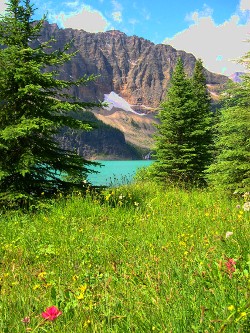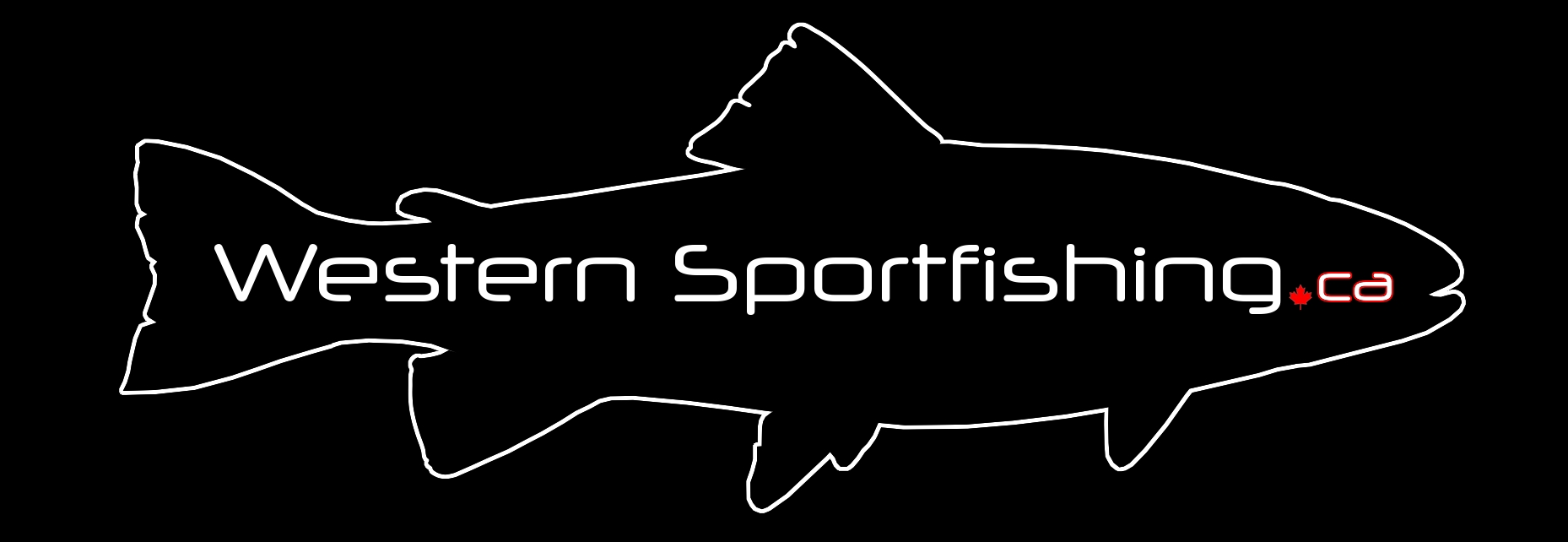
Destinations in Western Canada
The provinces of Alberta and British Columbia have such diverse landscapes, and a great variety of fishing opportunities. We like to showcase certain lakes, creeks, and rivers that we all enjoy fishing. Stay tuned to this section as we update it regularly with new hot spots!
Streams
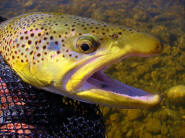 Brown Trout Creeks of Central Alberta: These creeks can generally be lumped together because they are pretty similar. Prairie Creek, the Raven River and the Little Red Deer River are small to medium sized and contain brown trout, brook trout, whitefish, and even some bull trout. The fishing can often be spotty because brown trout are very moody, but these creeks offer outstanding fishing on a fairly consistent basis. Fishing is best in spring and fall when water temperatures are favourable to trout activity. Stonefly, caddis, mayfly and terrestrial patterns are favoured, and dries and nymphs should be tried. These creeks are found between Rocky Mountain House and Olds (about) on Hwy 22 and its tributary Highways.
Brown Trout Creeks of Central Alberta: These creeks can generally be lumped together because they are pretty similar. Prairie Creek, the Raven River and the Little Red Deer River are small to medium sized and contain brown trout, brook trout, whitefish, and even some bull trout. The fishing can often be spotty because brown trout are very moody, but these creeks offer outstanding fishing on a fairly consistent basis. Fishing is best in spring and fall when water temperatures are favourable to trout activity. Stonefly, caddis, mayfly and terrestrial patterns are favoured, and dries and nymphs should be tried. These creeks are found between Rocky Mountain House and Olds (about) on Hwy 22 and its tributary Highways.
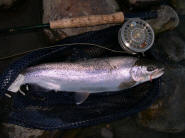 Bow River
(AB): The Bow River has been
called the greatest dry fly trout stream in the world, and North America’s
finest trout stream since its “discovery” in the late 70’s, and for good
reason. Very few locations offer dry fly fishing for rainbow and brown
trout that routinely top the two-foot mark. To make it even better, many
of these fish rise freely, and can be located in water less than 12 inches
deep, creating some very exciting moments. The best season for dry fly
fishing is May, and then again from the end of run-off through September.
Hatches of caddis, PMD, golden stoneflies, hoppers and BWO are the main
attractions. When the dry fly fishing is spotty, generally due to hot
weather, don’t be afraid to drop a team of nymphs down to the river
bottom. Top nymphs include the San Juan Worm, hares ear, pheasant tail,
prince, and golden stone. Streamers also work very
well, especially in high and slightly off-coloured water. Throwing wooly
buggers to the banks can be a great way to get some big browns during the
June Monsoons. Access is fairly good due to boat launches and the fact
that some of the best fishing can be accessed off of walking trails within
Calgary’s city limits.
Bow River
(AB): The Bow River has been
called the greatest dry fly trout stream in the world, and North America’s
finest trout stream since its “discovery” in the late 70’s, and for good
reason. Very few locations offer dry fly fishing for rainbow and brown
trout that routinely top the two-foot mark. To make it even better, many
of these fish rise freely, and can be located in water less than 12 inches
deep, creating some very exciting moments. The best season for dry fly
fishing is May, and then again from the end of run-off through September.
Hatches of caddis, PMD, golden stoneflies, hoppers and BWO are the main
attractions. When the dry fly fishing is spotty, generally due to hot
weather, don’t be afraid to drop a team of nymphs down to the river
bottom. Top nymphs include the San Juan Worm, hares ear, pheasant tail,
prince, and golden stone. Streamers also work very
well, especially in high and slightly off-coloured water. Throwing wooly
buggers to the banks can be a great way to get some big browns during the
June Monsoons. Access is fairly good due to boat launches and the fact
that some of the best fishing can be accessed off of walking trails within
Calgary’s city limits.
Crowsnest River
(AB): The Crow. Perhaps Alberta’s best trout stream. It’s certainly in the top two or three. Small enough to wade and cross at will, yet large enough to grow lots of trout, lots of big trout –this stream is perhaps the ultimate in Intelligent Design, especially if God were a fly-fisher. It isn’t too small or too big. It’s perfect. There are endless amounts of holding water types, and trout abound in all of them. It seems that every yard of stream has a fish. Rainbow, cutthroat, cuttbow, brown, brook and some bull trout are present, and there are lots of whitefish. Even lake trout are caught from time to time. Rainbow trout are found all throughout the stream and are the main draw, and they average from 10-16 inches. Generally speaking, the trout average about twelve or fourteen-inches below Hillcrest, and ten or twelve-inches above. Larger trout (20” or bigger) are also more abundant between about Hillcrest and the Oldman Reservoir, but are also present (albeit in smaller numbers) between Crowsnest Lake and Hillcrest. Without a doubt, it is the stoneflies (salmonflies and golden stones) of spring and early summer that are the most glorified hatches on the Crow, but there are a host of mayflies (PMD, BWO, Green Drake, Pseudo, Trico, March brown, and more), caddis, midges and terrestrials that lead to some of the finest dry fly fishing anywhere. Nymphing with TNTs, copper Johns, stoneflies, SJ worms, and other general nymphs work well when nothing much else is happening. Wet flies swung down and across work surprisingly well. This stream can be quite technical, and it can really test your skills as a fly fisher. Use 3-5 weight rods in calm conditions, and 5-6 weights if the Crowsnest Pass wind is bad, or nymphing is the order of the day. The Crow is one of the best trout streams you will ever fly fish, so it is worth the time to get to know.
Elk River System (BC): The Elk River system is a well-known destination for fly anglers. Good fishing for cutthroat trout, bull trout and mountain whitefish can be found in the majority of the system. As with the Oldman River system, the fishing is generally best after runoff is complete. This is usually a week or two into July; but early season fishing can be spectacular should you find clearer water. Stoneflies, green drakes, as well as various other mayfly and caddis species ensure that dry fly fishing is almost always a possibility. Fernie, Elkford, or Sparwood are good central locations to camp at, and use as a home base for exploring the area. The Elk River and tributaries are listed as Classified Waters. Be sure to consult the British Columbia Sportfishing Regulations for details.
Mcleod River System (AB): The upper Mcleod River and nearly all of its tributary streams hold coldwater sport fish: arctic grayling, brook trout, bull trout, whitefish, Athabasca rainbows, and even some brown trout. Most of the trout are located upstream of Edson, off Hwy 47, but some downstream tributaries hold trout, and the lower Mcleod offers up whitefish, grayling, pike and walleye. The Mcleod itself is known mostly as a whitefish river that offers decent chances at trout and grayling. The upper tributaries, though, are fantastic fisheries, offering all the aforementioned species. The small creeks are often seen as more profitable to fish than the Mcleod itself, and some of them are very productive. Aside from whitefish fishing, the Mcloed is known largely for its grayling, and the fishing for them is pretty good in late summer and fall. The Mcleod and its tributaries upstream of the Embarass River confluence are small enough to fish comfortably with an 8-8.5-foot 3-5 weight, and downstream from there a 9-foot 5-6 weight is the most useful tool. Bead head nymphs work best for whitefish anglers, and a hopper-dropper setup is deadly on the trout and grayling. The streams in this region sometimes offer strong hatches of various caddis, mayflies, or stoneflies, but the hatch season is short, and searching with something like a stimulator, elk hair caddis, or Adams will catch as many fish as anything else. Runoff often doesn’t end until July, so plan on a fishing season that lasts from mid-July to mid-September.
North Ram River (AB): The North Ram River
was the first river in Alberta to be designated catch and release, in
1982. This was to help protect the introduced cutthroat trout as
over-fishing and severe flooding was decimating the fishery. The result
has been one of the best trophy cutthroat fisheries in the province. The
season opens on June 16 annually and can be good from opening day to
closing day providing that there is no severe spring flood, or any fall
storms to keep an angler from casting a line. The dry fly fishing can be
very good as hatches of stoneflies, mayflies and caddis’ are common
occurrences for the majority of the season. Make sure you carry a wide
selection of dries; and using a small dropper fly is a sure fire way to
maximize your fishing time. The majority of the fish are located in the
slower, deeper spots, so concentrate on the prime water.
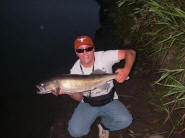 North Saskatchewan River (AB): The North Saskatchewan River is a gem that goes largely unnoticed by visitors. The fishing is really rewarding once you get to know a little about the river, and there are many species present. There are whitefish, goldeye (mooneye are also present), pike, walleye, sauger, saugeye, suckers, sturgeon, brown and bull trout present. Most of the fishing we do is for pike, walleye, and goldeye. The fishing is good almost anytime the water is clear (and often when it is not). The fishing can be good almost anywhere below Abraham Lake (west of Nordegg) if you hit it at the right time of year, and in the right conditions. Directions are futile, as the river flows through the entire province, starting in Banff National Park. The best advice would be to just go and fish it. The fishing in the Edmonton region is some of the best on the river, and past provincial record walleye have been taken from this section of the North Saskatchewan.
North Saskatchewan River (AB): The North Saskatchewan River is a gem that goes largely unnoticed by visitors. The fishing is really rewarding once you get to know a little about the river, and there are many species present. There are whitefish, goldeye (mooneye are also present), pike, walleye, sauger, saugeye, suckers, sturgeon, brown and bull trout present. Most of the fishing we do is for pike, walleye, and goldeye. The fishing is good almost anytime the water is clear (and often when it is not). The fishing can be good almost anywhere below Abraham Lake (west of Nordegg) if you hit it at the right time of year, and in the right conditions. Directions are futile, as the river flows through the entire province, starting in Banff National Park. The best advice would be to just go and fish it. The fishing in the Edmonton region is some of the best on the river, and past provincial record walleye have been taken from this section of the North Saskatchewan.
Red Deer River (AB): This is a fantastic river. Large amounts (and sizes) of whitefish are present, pike
and walleye are relatively abundant, goldeye are exceptional in season,
and, if you know where to look, the brown trout fishing can be downright
exciting. The part of the river we fish is between the Dickson Dam and
the city of Red Deer. All off the above mentioned species are found in
this stretch, and with the aid of a boat it is very easy to access. Our
favourite spots to try are generally between the Dickson Dam and the
Innisfail bridge on Hwy 54. For whitefish, try any nymph, and red seems to
be a good colour. Other than nymphing for whites I prefer to fish for the
elusive browns; and, streamers or dry flies are good methods for this. Try big
streamers fished in all the likely water. When fishing like this it is
quite easy to hook up with the pike and walleye as well. There are great
hatches to fish in season, and the stoneflies, caddis’, mayflies and
terrestrials will get the fish looking up.
Shunda Creek (AB): There is a serene little stream fishing out of hills by Nordegg called Shunda Creek. It holds many small brook and brown trout, and does also give up the odd large fish, reportedly as long as 18 or 20 inches. This is one of the best streams in Alberta for a beginner to catch a brown trout, because the fish are plentiful and generally forgiving, even near campgrounds. There are three provincial campgrounds on Shunda (all just off Hwy 11). These campgrounds make good base camps for exploring the area, due to their proximity to Nordegg (for gas, beer, and other supplies), Hwy 11, and the Forestry Trunk Road. Much of the creek is slow and flat (including beaver ponds), and the brown trout cautiously eat bugs off the flat water. Other sections of the creek are a little bit rockier, providing nice riffles and classic pools. Trout hold in all the traditional lies throughout the creek’s length. A small dry fly, such as an Adams or elk hair caddis, will work as often as not, and a small dropper nymph will entice some of the less gullible fish. Rising fish are common, even during periods of sparse hatches. Because the average fish is on the small side, and the casting typically at short distances, a light dry fly outfit (2-3-weight) is the perfect tool for fishing Shunda Creek. The fishing can be good anytime from May to October. If the stream blows out due to heavy rain, nearby Fish (Shunda) and Goldeye Lakes offer rainbow trout fishing.
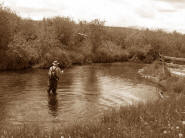 Stauffer Creek (AB): This is unquestionably
Alberta’s best spring creek, and one of the best locales in Alberta for
fishing. The number of brown trout per mile was once around the 1200
mark, and keep in mind this stream is less than a dozen feet wide for much
of its length. The browns are monsters and so are the hatches. To keep
on the same vein, so are most of the people who fish there. Well, they
don’t start out like that, but after several beatings you can only have a
short temper remaining at best. The hatches go all season, so it would be
impossible to talk about them all here, but the favorites for us are the
drake hatches of June, the caddis of May-September, and the boatmen in
September. The most popular season for Stauffer is May-June, due to the
limited number of run-off free streams in Alberta, and the fact that 24”
browns are sucking down #8 green drakes.
Stauffer Creek (AB): This is unquestionably
Alberta’s best spring creek, and one of the best locales in Alberta for
fishing. The number of brown trout per mile was once around the 1200
mark, and keep in mind this stream is less than a dozen feet wide for much
of its length. The browns are monsters and so are the hatches. To keep
on the same vein, so are most of the people who fish there. Well, they
don’t start out like that, but after several beatings you can only have a
short temper remaining at best. The hatches go all season, so it would be
impossible to talk about them all here, but the favorites for us are the
drake hatches of June, the caddis of May-September, and the boatmen in
September. The most popular season for Stauffer is May-June, due to the
limited number of run-off free streams in Alberta, and the fact that 24”
browns are sucking down #8 green drakes.
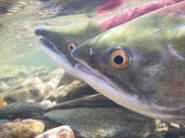 Stellako River (BC): The Stellako River is located a little over an hour's drive
on Hwy 16, west of Prince George, near the town of Fraser Lake. Each fall
thousands of sockeye salmon enter the river to spawn, and the large
rainbow trout take advantage of this. Fishing egg flies, egg sucking
leeches, and matching the hatch will work well for you on this river. The
river sees a lot of pressure at the upstream end, where it exits Francois
Lake, but for anglers willing to hike, solitude can still be found. This
is a classified stream, meaning anglers will have to buy a Class 2
Classified license, but the cost is well worth it. The rainbows can grow to be
exceptionally large (so can the white fish. WOW!).
A minimum of a 6 weight rod is advised,
with nothing lighter than 4x tippet. The faster water has always been
more productive, but do lots of exploring.
Stellako River (BC): The Stellako River is located a little over an hour's drive
on Hwy 16, west of Prince George, near the town of Fraser Lake. Each fall
thousands of sockeye salmon enter the river to spawn, and the large
rainbow trout take advantage of this. Fishing egg flies, egg sucking
leeches, and matching the hatch will work well for you on this river. The
river sees a lot of pressure at the upstream end, where it exits Francois
Lake, but for anglers willing to hike, solitude can still be found. This
is a classified stream, meaning anglers will have to buy a Class 2
Classified license, but the cost is well worth it. The rainbows can grow to be
exceptionally large (so can the white fish. WOW!).
A minimum of a 6 weight rod is advised,
with nothing lighter than 4x tippet. The faster water has always been
more productive, but do lots of exploring.
Upper Oldman System (AB): The upper Oldman River and the Livingstone River are
the most widely known of the Oldman system streams, and
are probably the best of the bunch. The fishing is
primarily for cutthroat trout, but cuttbows, rainbows, bull trout and rocky
mountain whitefish can all be caught. The fishing
opens each year on June 16, but the fishing doesn't really pick up until
runoff is over, which usually happens by mid July. Don't let this stop
you from fishing the early season though, as nymph fishing can produce
well, and the cutthroats are coloured spectacularly at this time.
Once runoff is over, the fishing is good all summer long with dry flies
leading the way. Stimulators, wulffs, green drakes and caddis' are all
good bets, and more and more fish are being caught on smaller flies
like PMD's and BWO's. Both of these streams are accessed on the Forestry
Trunk road north of Coleman. Campgrounds are scattered in the area, and a lot of random
camping takes place. Probably too much takes place, and once the May long weekend comes,
squatters litter the clearings and roadside turnouts all summer, making the system
an often unenjoyable place to visit. Hopefully the government will soon
correct this.
Lakes
Baptiste Lake
(AB): Baptiste has long been known as a quality pike and walleye lake, and the fishing for them can be very good. Unfortunately, too many years of over-abusive catch and kill regulations have resulted in a decimated fishery. Even the large perch that were once common are rare. Pike and walleye now have a limited kill limit, and while many locals are upset, the fishery will likely rebound and be almost as good as it once was. Good fish can still be found, however. Large pike inhabit the shallower bays early on in the season, and can be hunted in slightly deeper water throughout the summer. Walleye fishing is excellent, and jigs tipped with minnows, leeches, or nightcrawlers are often top producers. Fly-fishing is productive, especially from May through early July, and both pike and walleye can be enticed to bite imitative and attractive streamers. The perch can be tough to find, but once they are located, some big ones can be landed. Even with lower numbers of big fish, the major drawback to Baptiste is the amount of powerboats on the lake –long weekends are a zoo, and you’re better off staying home to avoid frustration over the noise and ignorance. (Honest.) Otherwise, the fishing is good, and because of the fisheries status, fewer people than before are fishing here.
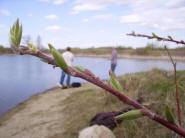 Cardiff Park Pond (AB): Located just south of Morinville, the
oddly shaped pond at Cardiff is a great place for Edmonton anglers to
enjoy an evening of fly-fishing. The rainbow trout fishing at this old
coal mine is often very good, and in the event of a slow day, the
omnipresent perch can usually be counted on for some action. While the
entire shoreline is accessible to anglers (you’ll have to walk a short
distance from the parking lot), much of it is steep; pretty fly-casting is
tough, but getting your fly to the productive water is rarely a problem
because drop offs are typically close to shore. Summer fishing can become
a little slow, but spring and fall fishing is often very fast and
furious. There are a couple docks that provide access for
mobility-restricted fishers. Productive flies include candy cane
chironomids, lakeside leeches, TNTs, dragonfly nymphs, and elk hair
caddis. Using a couple little flies below a strike indicator is probably
the most consistent method at Cardiff. The fish average about 8 or10
inches and typically run to a little over a foot-long, though large fish
are apparently caught (you’ll often hear rumours, but never see
pictures). There is a lot of bait fishermen who come here, so you won’t
have Cardiff to yourself, but that isn’t the reason to go to a stocked
trout pond this close to Edmonton –fresh air, exercise, and a few trout
are.
Cardiff Park Pond (AB): Located just south of Morinville, the
oddly shaped pond at Cardiff is a great place for Edmonton anglers to
enjoy an evening of fly-fishing. The rainbow trout fishing at this old
coal mine is often very good, and in the event of a slow day, the
omnipresent perch can usually be counted on for some action. While the
entire shoreline is accessible to anglers (you’ll have to walk a short
distance from the parking lot), much of it is steep; pretty fly-casting is
tough, but getting your fly to the productive water is rarely a problem
because drop offs are typically close to shore. Summer fishing can become
a little slow, but spring and fall fishing is often very fast and
furious. There are a couple docks that provide access for
mobility-restricted fishers. Productive flies include candy cane
chironomids, lakeside leeches, TNTs, dragonfly nymphs, and elk hair
caddis. Using a couple little flies below a strike indicator is probably
the most consistent method at Cardiff. The fish average about 8 or10
inches and typically run to a little over a foot-long, though large fish
are apparently caught (you’ll often hear rumours, but never see
pictures). There is a lot of bait fishermen who come here, so you won’t
have Cardiff to yourself, but that isn’t the reason to go to a stocked
trout pond this close to Edmonton –fresh air, exercise, and a few trout
are.
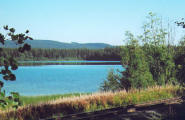 Hart Lake (BC): Hart Lake is located approximately 45
minutes north of Prince George, BC on Hwy 97
(Hart Hwy) just before the small town of Bear Lake. There is a parking
lot at the lake, as well as a small pier, but your boat must be carried
several meters to the water's edge. This lake is ideal for float tubes and
pontoon boats. There are many shoals in this lake for the fly fisher to
explore, and good fishing can be found around the entire lake, with the
exception of the shallows that stretch out from the boat launch. Chironomids, scuds, dragonflies, and leeches are all excellent patterns to
use when fishing Hart Lake. The rainbows reach good sizes, with an
average of about 14-16 inches. The fishing can be exceptionally good all
season, keeping in mind the fishing can slow down during long hot spells.
Hart Lake (BC): Hart Lake is located approximately 45
minutes north of Prince George, BC on Hwy 97
(Hart Hwy) just before the small town of Bear Lake. There is a parking
lot at the lake, as well as a small pier, but your boat must be carried
several meters to the water's edge. This lake is ideal for float tubes and
pontoon boats. There are many shoals in this lake for the fly fisher to
explore, and good fishing can be found around the entire lake, with the
exception of the shallows that stretch out from the boat launch. Chironomids, scuds, dragonflies, and leeches are all excellent patterns to
use when fishing Hart Lake. The rainbows reach good sizes, with an
average of about 14-16 inches. The fishing can be exceptionally good all
season, keeping in mind the fishing can slow down during long hot spells.
Lac Ste Anne (AB): This is a very popular lake, located a little less than an hour west of Edmonton. The
fishing is fun during any season for pike, walleye and whitefish, and the
winter can produce some nice burbot fishing as well. The
walleye limit has been zero for many years, and the fishing has
really picked up for them. Try fly fishing with
chartreuse, black or white streamers, and gear fishing with spoons or jigs
right near the bottom for walleye. For pike, anything goes, but some of
our favourites are large streamers, poppers, Little Cleo spoons, and hawg
frogs (don’t snicker until you try it). Just fish any of the weed beds
for pike, they are all worth trying. Whitefish
can be caught on fly gear in the spring (though they are elusive),
and through the ice by using wire worms and jigging spoons.
Walleye are all over the lake now. If you desire big pike, you will
want to go to Wabamun Lake, which is nearby.
Lower Chain Lake (AB): Situated near Athabasca, some two and a
quarter hours from Edmonton, Chain Lake’s trout don’t see the pressure
that more local fish receive. It does get some attention from northern
fishermen, but this is mostly on the weekends. The lake is about 60 acres
in size, and this is more than enough space to spread out the modest
weekend crowd. The “electric motor only” regulation helps keep the lake
pleasing to fish, even with a few anglers on the water, and it is quite
peaceful and quiet. Largely made up of shoals in the 12-18 foot range,
Chain Lake has a gradual drop off and some upwelling springs that add to
its productivity. Chironomids, leeches, and dragonfly patterns are
fantastic choices almost any time, and caddis hatches can even bring some
of the bigger fish to the surface. The Alberta government stocks
rainbows and tiger trout into Chain.
Muir Lake (AB):
Muir Lake is a trout lake in the Edmonton area that offers some
quality fly
fishing. The regulations allow for one rainbow or brown trout over 50 cm per day, and a bait ban, with a
seasonal closure to prevent ice fishing. There is also a speed
restriction on the lake, which is currently 12km/h. As for the fishing,
it is really quite simple. The entire lake is made up of shoals, and the
fishing can be good all throughout the lake. Much
of the lake is less than 7 or 8 feet deep, but the 10-17 foot
depths seem to be the best producers. Chironomids
are a successful fly almost all season long. A big black bomber is preferred,
but all colours should be tried. Leeches and minnow patterns also account for fish, as do
damsels, dragons, and backswimmer/boatmen patterns.
